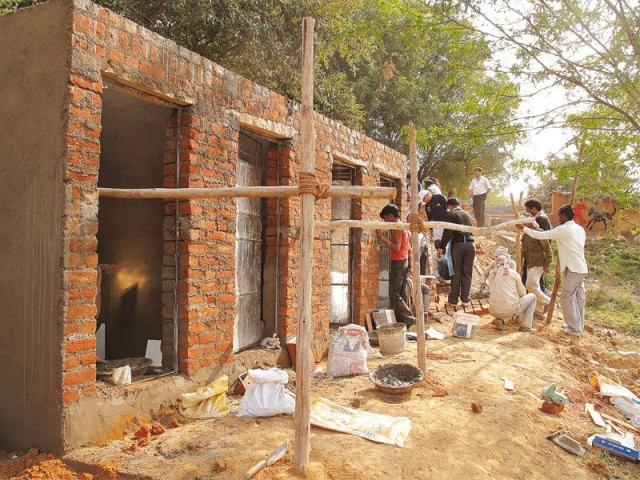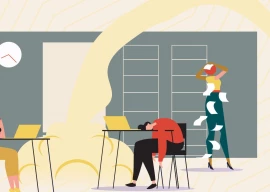
In his hands was a sanitary napkin — that cost just one rupee to make. Kunal had never touched one before in his life. “It’s so awkward,” he said. His education had just begun.

Arunachalam Muruganathanam receiving the best invention award for the betterment of society from the Indian Institute of Technology in Chennai in 2006 from president Pratibha Patil. PHOTOS : MAHIM MAHER
In fact, many of Kunal’s classmates were having the same reaction. These boys of the famed boarding Scindia School in Gwalior (five hours by road from Delhi) were hosting six schools for a Round Square community service project from December 15 to 20. Attending it were students from Karachi’s Lyceum School, Maharani Gayatri Devi school in Jaipur, The Millennium School in Dubai, The Daly College in Indore, the Scindia Kanya Vidyalaya of Gwalior, the Pinegrove School of Shimla and the Indian High School in Dubai as the Round Square is a worldwide association of schools.

The focus of the project was improving the hygiene of a village called Nathon ka Pura outside town. Part of it included a visit to the girls school, Scindia Kanya Vidyalaya (SKV), that had acquired an award-winning invention to make the dirt-cheap sanitary essentials for the women there.
The SKV girls had discovered that the women in the village, who could not afford branded sanitary napkins, would use rags, leaves and even sand each month. “Their dignity and health [are affected],” remarks Medha Inamdar, an SKV biology teacher, who was due to make another delivery of napkins the next day.
The napkins are produced by a patented machine created by the now world-famous Arunachalam Muruganantham, who started Jayaashree Industries in Coimbatore in 2006. Muruganantham discovered that his wife was using rags as they couldn’t afford the products of multinational companies. He started experimenting and discovered that wood pulp and biodegradable materials like banana fibre can be just as good. He was given the Best Innovation Award by the President of India, Pratibha Patil, for his work which became the subject of a documentary, Menstrual Man, in 2013. “We have [sent] 1,300 machines across India and to countries such as Nepal, Bangladesh, Nigeria and even the US,” he tells The Express Tribune over the phone from Coimbatore. But he refuses to give it to ‘commercial’ businesses and will only entertain self-help groups.

Students worked for four days to mix cement and pass bricks to help build the four toilets for women at the edge of Nathon ka Pura outside Gwalior. The village children are the only ones who helped. PHOTOS : MAHIM MAHER
The machine needs an investment of just INR75,000 and today stands in a small room on the ground floor of the SKV school. The girls make the napkins, package them into blocks of five and distribute them in the village each month for free. “It’s the kind of invention in which you say, ‘Why didn’t I think of this?’” remarks SKV Principal Nishi Misra.
The machine is laid out on stations, that will fit on eight desks. First you tear up raw cotton sheets or any of the other raw materials, strip them of the fibre in a stainless steel container like a bucket with a motor at the bottom. This de-fibration machine whips the material so it becomes fluffy. You then compress 12 grammes of the fluff into a rectangular mould. The water-proof strip is slipped under and the napkin is sealed into an absorbent tissue-cloth, after which the adhesive strip of oil paper is applied. The napkin is heat-sealed and sterilised in a UV chamber.

There are no unmarried girls over the age of 13 years in Nathon ka Pura as they are married off. There are several water pumps in the village but the superstitious parents generally don’t like bathing the children as one child once died the morning after being given a bath. Scindia School teacher Jasman Preet tried to break the myth by bathing one child here. PHOTOS : MAHIM MAHER
Muruganantham favours schools taking up this work. “Why don’t we [get them] at the girl stage,” he says, explaining that he felt that while women empowerment was all well and good, sometimes villages had trouble with women getting permission for such projects. Girls telling their mothers was a bottom-up approach that he felt made sense too.
Women in Pakistan are doing pretty much what many women in India are during their cycle. Not all of them have easy access to affordable feminine care products. Datamonitor, a London-based research company, estimated that by the end of 2009, Pakistan’s market size for napkins was Rs1.1 billion and would grow to Rs2.1 billion by 2015. But surprisingly few here have contacted Muruganantham. “We have received many commercial inquiries from Pakistan,” he tells The Express Tribune, “but none from social [welfare/community] groups, NGOs or the government.”
Aside from being inspired by the self-help sanitary napkins, the Round Square project schools wanted to accomplish another essential: build four toilets in Nathon ka Pura where the women had to go to the bushes and had little privacy.
For four days, the 60 students from the seven schools sifted through gravel, mixed cement, carried it in tubs to the site and passed bricks from the roadside pile. This included five students from The Lyceum School in Karachi who had been quizzed at home on why they would want to build a toilet in India? The principal of the host Scindia School was well prepared to tackle this cynicism. “These things are actually global,” says Samik Ghosh. “[It is the thinking that] I’ll help somebody and do something for someone less privileged.”

There are no unmarried girls over the age of 13 years in Nathon ka Pura as they are married off. There are several water pumps in the village but the superstitious parents generally don’t like bathing the children as one child once died the morning after being given a bath. Scindia School teacher Jasman Preet tried to break the myth by bathing one child here. PHOTOS : MAHIM MAHER
The four toilets were constructed at the edge of the village at the bottom of a small incline. The run-off grey water from the village hand-pump was channelled into a tank. This recycled water would be used to flush the toilets and a septic tank was constructed at the other end to dispose off the waste.
The hardest part, because of its sheer repetitive nature, was passing the bricks. The students attacked the task with good cheer but slowly started to notice that the men of Nathon ka Pura were completely ignoring them and not offering to pitch in. In fact, the squatting men just played round after round of cards; at one point an inebriated lush came and started spewing abuse. The women didn’t come forward either, but that was perhaps understandable. They stayed at home for the most part. It was the children, weighing little more than the bricks themselves, who came forward to take ownership and inserted themselves into the students’ ranks to lend a tiny hand.
The destitute Nathon ka Pura was not always this hard up and its men not so apathetic. Some of them said that the turning point came two to three years ago when the Indian government had banned snake charming. Snake charming was the main profession here — hence the name ‘Naath’ ka Pura. Actually, the ban on possession of snakes dates to 1972 to protect wildlife and thus applied to the sacred pythons and cobras. The decision was partly based on the fact that the snakes would starve to death as their fangs were removed. From time to time since, the government has cracked down on the public display of snakes, particularly during the Shrawan month when the festival of Nag Panchami falls. The law was amended in 2003 to make punishments stricter. And in 2009, snake charmers formed a union to try and defy the ban as it had affected over 100,000 families.
One of the out-of-work snake charmers at Nathon ka Pura was 35-year-old Jagdeesh who used to own a “Kala Phan Wallah,” or black cobra. “We defanged it and extracted the poison,” he explains. “I didn’t have a flute so I’d make it sway with a chutki [snap of my fingers].” He and the other snake charmers would still be able to make a little bit of a living by either entertaining people from village to village or by taking part in Naag Panchami. “We would go to homes where they would call us for pooja,” he said. “We would hold the head of the snake and the women would apply a teeka.”
With the crackdowns though, the villagers lost their source of income and had to release the snakes into the wild. The onus of earning fell to the women who started gathering wood and selling it for INR100 a bushel. “The women mostly earn and bring the money home and then the men take it and drink it away,” explains Khemsingh Yadav, a 74-year-old retired school teacher and social worker who comes to help from the neighbouring Sonsa village.
Today the people of Nathon ka Pura rely on ration cards. The yellow below-the-poverty-line booklets are for the people who earn just INR1,200 a month. They are thus eligible for 20kg of flour among other essentials. But many people claimed that they needed to give bribes just to get a yellow booklet. “We are cheated on the weight of the flour as well because we don’t know how to read,” says Jagdeesh to Rahul Pandey, a student from the Scindia School, who was doing a village survey. But Pandey quizzed Jagdeesh on how he could claim he couldn’t read his ration card entries given that he played cards and used a mobile phone with numerals on it.
It was, of course, with irony that when Pandey reported this back to the group, someone mentioned a 2010 UN report that had pointed out that Indians have easier access to cell phones than toilets.
Mahim Maher is an editor at The Express Tribune. She tweets @Mahim_Maher
Published in The Express Tribune, Sunday Magazine, January 5th, 2015.


















COMMENTS
Comments are moderated and generally will be posted if they are on-topic and not abusive.
For more information, please see our Comments FAQ